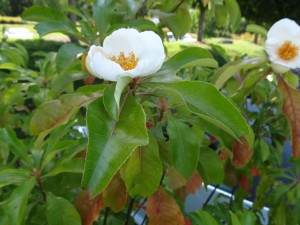Franklinia (Franklinia altamaha) is admittedly a very finicky large shrub or small tree. Pure white, five-petal, 2 ½ – 3 inch camellia-like flowers bloom sporadically from August thru mid-October. Flowers are slightly fragrant. In the fall glossy green leaves gradually transition to blends of red, orange and burgundy hues.
Franklinia grows best on an eastern exposure site with full morning sunlight and sheltered from strong afternoon sun. Franklinia has a fibrous root system, preferring soil conditions similar to azaleas and rhododendrons. If growing rhododendrons are a challenge, stay away from franklinia. Soil must be compost-rich, excellently drained, and moderately acidic.
Franklinia was named to honor Benjamin Franklin. Originally discovered growing in southeastern Georgia (USDA zone 8), franklinia grows surprisingly well in our cooler Southern Appalachian region (USDA zones 6 and 7). The species is extinct in the wild, but readily available from internet nursery commerce.
Fertilize in early spring with an acidic based soluble fertilizer such as Miracle Gro®, Miracid®, or Hollytone®. Franklinia also favors an annual feeding of Epsom salts (magnesium sulfate) @ 1 Tablespoon per gallon of water per tree. Applying limestone or gypsum anywhere around the feeder roots of franklinia is highly discouraged.


 Posted in
Posted in 
